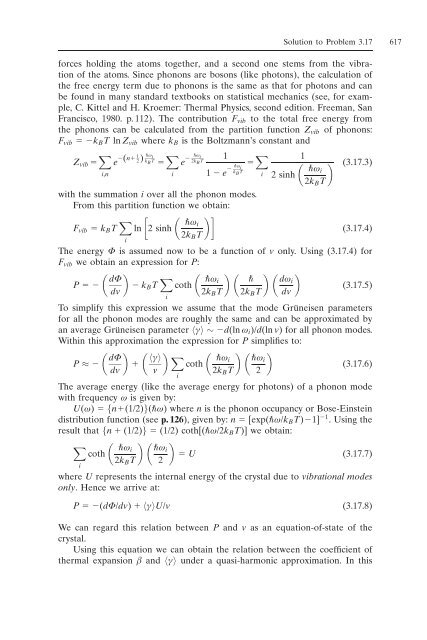10. Appendix
You also want an ePaper? Increase the reach of your titles
YUMPU automatically turns print PDFs into web optimized ePapers that Google loves.
Solution to Problem 3.17 617<br />
forces holding the atoms together, and a second one stems from the vibration<br />
of the atoms. Since phonons are bosons (like photons), the calculation of<br />
the free energy term due to phonons is the same as that for photons and can<br />
be found in many standard textbooks on statistical mechanics (see, for example,<br />
C. Kittel and H. Kroemer: Thermal Physics, second edition. Freeman, San<br />
Francisco, 1980. p. 112). The contribution Fvib to the total free energy from<br />
the phonons can be calculated from the partition function Zvib of phonons:<br />
Fvib kBT ln Zvib where kB is the Boltzmann’s constant and<br />
Zvib <br />
1 (n<br />
e 2)<br />
i,n<br />
ˆi <br />
kBT e<br />
i<br />
ˆi 1<br />
2kBT 1 e ˆ <br />
i<br />
kBT 1<br />
(3.17.3)<br />
ˆi<br />
i 2 sinh<br />
2kBT<br />
with the summation i over all the phonon modes.<br />
From this partition function we obtain:<br />
Fvib kBT <br />
<br />
ˆi<br />
ln 2 sinh<br />
(3.17.4)<br />
2kBT<br />
i<br />
The energy º is assumed now to be a function of v only. Using (3.17.4) for<br />
Fvib we obtain an expression for P:<br />
<br />
dº<br />
P kBT<br />
dv<br />
<br />
<br />
ˆi dˆi<br />
coth<br />
(3.17.5)<br />
2kBT 2kBT dv<br />
i<br />
To simplify this expression we assume that the mode Grüneisen parameters<br />
for all the phonon modes are roughly the same and can be approximated by<br />
an average Grüneisen parameter 〈Á〉 ∼d(ln ˆi)/d(ln v) for all phonon modes.<br />
Within this approximation the expression for P simplifies to:<br />
<br />
dº 〈Á〉 <br />
<br />
ˆi ˆi<br />
P ≈ <br />
coth<br />
(3.17.6)<br />
dv v<br />
2kBT 2<br />
i<br />
i<br />
The average energy (like the average energy for photons) of a phonon mode<br />
with frequency ˆ is given by:<br />
U(ˆ) {n(1/2)}(ˆ) where n is the phonon occupancy or Bose-Einstein<br />
distribution function (see p. 126), given by: n [exp(ˆ/kBT)1] 1 . Using the<br />
result that {n (1/2)} (1/2) coth[(ˆ/2kBT)] we obtain:<br />
<br />
<br />
ˆi ˆi<br />
coth<br />
U (3.17.7)<br />
2kBT 2<br />
where U represents the internal energy of the crystal due to vibrational modes<br />
only. Hence we arrive at:<br />
P (dº/dv) 〈Á〉U/v (3.17.8)<br />
We can regard this relation between P and v as an equation-of-state of the<br />
crystal.<br />
Using this equation we can obtain the relation between the coefficient of<br />
thermal expansion ‚ and 〈Á〉 under a quasi-harmonic approximation. In this










